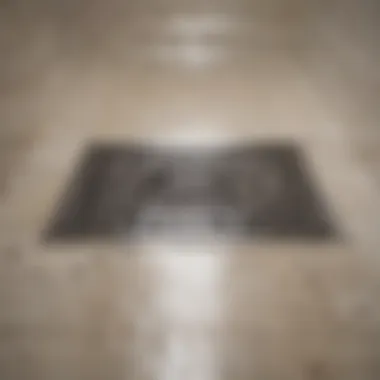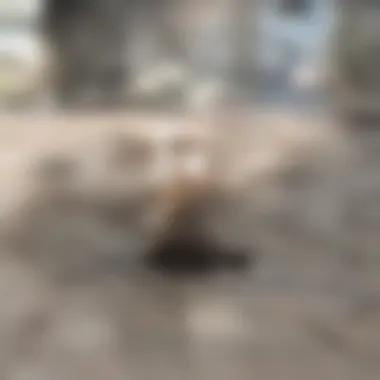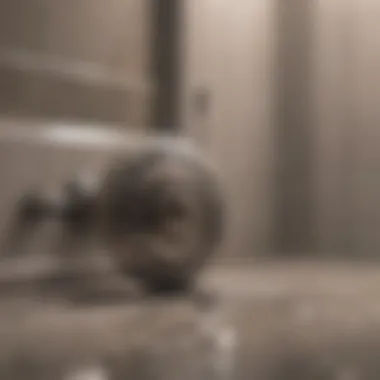The Essential Guide to Removing Shower Drain Grates


Intro
Removing a shower drain grate is a task many homeowners face at some point. It may seem straightforward, yet it often presents challenges. Understanding the process thoroughly can alleviate stress and ensure the job is done right. This guide aims to provide comprehensive insights into effectively removing a shower drain grate.
Several reasons might compel someone to tackle this task—be it for cleaning, repair, or inspection. Proper knowledge about the tools, methods, and potential issues involved can make all the difference.
The importance of this task cannot be understated. A properly maintained drain system plays a critical role in preventing water damage and related issues in bathrooms. With an effective approach to removing the grate, homeowners can preserve the integrity of their plumbing systems.
Here, readers will learn about the tools necessary, common obstacles that may arise, and essential maintenance tips to keep the system functioning smoothly. By the end of this article, individuals will have the confidence needed to remove a shower drain grate successfully.
Intro to Shower Drain Grates
In any home, shower drain grates play a critical role in the functionality of the plumbing system. They serve as the first line of defense against debris entering the drainage system, ensuring water flows freely and prevents clogs. Understanding shower drain grates is essential for homeowners. It allows them to perform necessary maintenance and ensure the overall health of their plumbing. Effective drainage is also integral for preventing water buildup, which could lead to mold or structural damage.
Understanding Shower Drain Functionality
Shower drains work by channeling water away from the shower area directly into the plumbing system. The drain grate covers the opening and prevents larger objects, such as hair or soap, from clogging the pipes. The effectiveness of the drain depends on its configuration and the quality of the materials used. A well-designed grate facilitates optimal water flow while minimizing the risk of blockages.
Some grates, especially those in older homes, may become clogged more easily due to poor design. Understanding how your shower drain works will help in recognizing when maintenance is necessary.
Types of Shower Drain Grates
Shower drain grates come in various styles and materials, each serving different aesthetic and functional purposes:
- Standard Grates: These are the most common type, often made from stainless steel or plastic. They usually feature a simple design and provide average drainage capabilities.
- Tile-Insert Grates: These allow for a seamless look by incorporating tiles that match bathroom flooring. This style is particularly popular for modern interiors, as it adds elegance while maintaining functionality.
- Linear Grates: These are long, narrow grates that can be installed at the shower entry point. They provide efficient drainage and are popular for their sleek design.
- Trench Grates: These grates extend across the entire width of the shower area, allowing for excellent water flow and drainage.
When selecting a shower drain grate, consider factors like style, material durability, and drainage efficiency. Adequate knowledge can also streamline the process of replacement or maintenance, ensuring that homeowners can take proactive measures.
Reasons for Removing a Shower Drain Grate
Removing a shower drain grate is often not considered until there is a problem. Understanding the reasons behind this action can not only enhance the functionality of the shower but also prevent future issues. Homeowners and property managers should recognize that regular removal and maintenance can vastly improve the longevity of their plumbing systems.
Cleaning and Maintenance
Regular cleaning is essential to keep a shower drain functioning well. Grates can accumulate hair, soap scum, and other debris, leading to restricted water flow. If left unattended, this build-up can cause unpleasant odors and staining around the drain area.


When the grate is removed, it allows for thorough cleaning, making it easier to reach all corners. You can wipe down the surface of the grate and scrub the area beyond it. Especially, using a mixture of vinegar and baking soda can help dissolve stubborn grime. This maintenance task can easily be performed every few months to ensure optimal performance.
Addressing Blockages
Blockages in drain lines can escalate quickly and lead to costly plumbing repairs. A shower drain can become clogged due to various materials, including hair, soap residues, and foreign objects. Identifying the source of the blockage is not always straightforward. Removing the grate brings clarity to the situation. You can visually inspect for blockages or even reach in to clear them by hand or using specific tools like a plumber's snake.
In addition, removing the grate can enable you to check for deeper issues in the plumbing system, such as misplaced pipes or advanced clogs. Addressing these issues promptly can save time and reduce stress down the road.
Installing a New Grate
Sometimes, the best solution is simply replacing an old or damaged drain grate. If the grate is corroded, it can significantly hinder water flow and create an unattractive appearance. Newer models of shower drain grates come in various materials such as stainless steel or plastic, offering better durability and style. Additionally, new designs are often easier to clean and maintain.
When upgrading, it’s important to consider the size and shape of your existing drain to ensure compatibility. Installing a new grate post-removal ensures a seamless fit, which enhances both function and aesthetic.
Properly addressing the installation of a new grate can prevent issues that arise from old, inefficient designs.
Tools Required for the Task
Removing a shower drain grate requires specific tools for effective execution. The right tools not only make the process smoother but also prevent potential damage to your plumbing fixtures. Using improper tools can lead to unnecessary complications, such as damaging the grate or even causing a leak if the drain is improperly accessed. This section outlines essential tools and safety equipment, ensuring you are well-prepared for the task ahead.
Essential Tools Overview
Having the appropriate tools is crucial when removing a shower drain grate. Below is a list of the essential tools you will need:
- Screwdriver: Depending on the type of grate, a flathead or Phillips screwdriver may be necessary. Check the screws holding the grate in place before beginning.
- Pliers: These are helpful in gripping and turning stubborn screws or nuts that may be stuck.
- Drain Snake: If you need to address a blockage afterward, a drain snake can aid in clearing debris.
- Putty Knife: This tool can help in lifting the grate without causing damage to the surrounding surfaces.
- Bucket: A bucket or container is essential for catching any water that spills from the drain during removal.
Each of these tools serves to facilitate the process while ensuring efficiency and safety. Make sure to gather them before beginning your work.
Safety Equipment
Safety should be a top priority when undertaking any home maintenance task, including removing a shower drain grate. You should consider the following equipment:
- Gloves: Wearing protective gloves can prevent skin contact with any harmful materials or bacteria present in the drain area.
- Safety Goggles: Protecting your eyes from debris is important, especially if you are using tools that could fling objects or water.
- Non-slip Footwear: Proper footwear minimizes the risk of slipping on wet surfaces. This is particularly critical in a bathroom setting.
By using this safety equipment, you not only safeguard your health but also ensure a more streamlined approach to the task. Proper preparation and consideration of safety measures can significantly improve your experience and outcomes during the removal of a shower drain grate.
"Preparation and the right tools lay the foundation for a successful maintenance project."


Step-by-Step Process for Removal
The process of removing a shower drain grate is more than just a simple task; it requires careful attention and methodical execution. This steps will not only ease the removal process but also help avert potential damages to your plumbing and surrounding area. By following a structured approach, you minimize the risks associated with drainage issues and ensure a clean workspace for yourself.
Preparation Steps
Before diving into the task of removing the shower drain grate, thorough preparation is essential. This stage is crucial as it sets the foundation for a successful and efficient removal process.
- Gathing Tools: Ensure you have the necessary tools at your disposal, such as a screwdriver, pliers, and any specific tools that may suit your grate type.
- Clear the Area: Remove any items around the shower area to create an unobstructed workspace. This not only aids in safety but also ensures that you do not misplace or damage personal items.
- Protect Surrounding Areas: Consider using a cloth or a mat to protect tiles or flooring from potential scratches or damages during the work.
This preparation will save you time and trouble during the actual removal process, providing a well-organized environment.
Removing the Grate
The act of removing the shower drain grate can be straightforward when approached methodically. Ensure that you follow these steps to achieve optimal results:
- Identify the Type of Grate: Understand the mechanism of your particular drain grate. Some may simply lift off, while others could require unscrewing.
- Disconnect Power Supply: If your shower has any electrical components related to heating or lighting, turn off the power. This is a safety measure.
- Loosen Screws or Clips: If your grate is secured with screws, carefully use a screwdriver to loosen them. In the case of clips, gently pry them open with pliers.
- Lift the Grate: After ensuring that all fastenings are free, lift the grate off using even pressure to avoid bending or breaking it.
- Inspect for Issues: Once removed, take a moment to observe both the grate and the area beneath for potential damage or clogs.
Effective removal is vital, as it directly impacts the subsequent maintenance and cleaning tasks.
Cleaning the Drain Area
After successfully removing the shower drain grate, the next priority is cleaning the area beneath it. Regular cleaning helps in preventing future blockages and sustaining the overall health of your plumbing system.
- Debris Removal: Use a small brush or cloth to remove any accumulated hair, soap scum, or other debris from the drain.
- Flush the Drain: Pour hot water down the drain to help dissolve any stubborn buildup. This will contribute to a clearer drainage system.
- Check for Damage: Inspect the drain area for any signs of rust, corrosion, or cracks. If you notice any abnormalities, it may be necessary to consult a professional.
Regular maintenance of the drain area promotes long-term efficiency and reliability of your shower drain system. Keeping the area clean not only enhances functionality but also contributes to the hygiene of your bathroom.
Common Challenges During Removal
Removing a shower drain grate may seem straightforward, but several challenges could arise during the process. Identifying and understanding these potential issues is crucial for avoiding damage to the grate and surrounding areas. It also ensures that the drain functions properly after the grate has been removed and re-installed or replaced. By being aware of these challenges, homeowners and DIY enthusiasts can prepare adequately, leading to more successful and efficient removal.
Stuck or Rusted Grates
One of the most common obstacles when removing a shower drain grate is dealing with grates that are stuck or rusted. This usually occurs due to moisture exposure over time, which can cause corrosion. A rusted grate can lead to frustration, especially if proper techniques are not used.
To address a stuck grate, you first must try to assess the situation. Applying some penetrating oil around the edges can help loosen the grate. A metal scraper or a flat-head screwdriver, when used carefully, can assist in prying up the edges. However, excessive force must be avoided as it can damage the grate or surrounding structure. Sometimes, adding heat to the area around the grate can expand the material slightly, making it easier to remove. A heat gun or hot water could be useful in this case.


Tip: Always check if the grate is meant to be rotated or lifted. Some models may have specific methods of attachment, which can save time and effort.
Damage to Surrounding Areas
Another concern during the removal process is potential damage to the surrounding areas, including the shower floor and plumbing. A careless attempt to forcefully remove the grate can lead to cracks in the tile or damage to the drain flange. Not only does this require additional repairs, but it can also lead to leaks that cause further complications.
To minimize the risk of damage, it’s important to work methodically and gently. Surrounding tiles should be inspected before starting the removal. If any tiles are cracked or loose, taking precautions like taping them down or marking the dislodged areas can be helpful. Using a specialized tool designed for grate removal can provide better control, reducing the potential for collateral damage.
In case damage does occur, knowing how to repair it promptly can save significant time and money. Regularly checking and maintaining the integrity of the surrounding structures can also prevent issues from arising during the grate removal process.
Post-Removal Maintenance
After successfully removing a shower drain grate, proper maintenance is essential to ensure the longevity and functionality of the drain system. Post-removal maintenance serves multiple purposes. First, it helps prevent future blockages by keeping the drain clean and monitored. Second, it allows homeowners to identify any potential damage that may have occurred during the removal process or over time. Lastly, consistent upkeep promotes overall hygiene, helping to reduce unpleasant odors and maximize water flow.
Regular Cleaning Practices
Regular cleaning is a fundamental aspect of post-removal maintenance. It can significantly reduce the chance of debris accumulation, which often leads to clogs.
- Develop a Schedule: Aim for at least monthly cleaning sessions. You can adjust the frequency based on your usage and the type of debris that typically collects.
- Remove Debris: Always remove any visible dirt or hair from the grate and surrounding area.
- Use Appropriate Cleaners: Consider using a mix of vinegar and baking soda to disinfect. This combination can effectively remove grime without causing harm to the plumbing system.
- Tool Utilization: Employ a soft-bristled brush to scrub the grate, making sure to address any hard-to-reach spots.
"Regular attention to the shower drain ensures better performance and reduces costly repairs later on."
This routine cleaning will help maintain the drain's efficiency and hygiene, leading to more favorable conditions over time.
Inspecting Drain Functionality
Aside from cleaning, inspecting drain functionality after removal is crucial. This process helps ascertain that the drainage system operates effectively and highlights any issues that may require immediate attention.
- Water Flow Check: After re-installing the grate, run water through the drain to check if it flows freely.
- Look for Backflow Issues: Observe for any signs of water backing up, which can indicate deeper drainage problems.
- Visual Inspection: Carefully examine the drain's markings and the area around it for any signs of corrosion or cracks that may lead to further complications.
- Consider Professional Help: If any significant anomalies arise during the inspection, consulting a plumbing expert may be prudent to address potential problems.
Consistent inspection ensures that the drain remains functional and can help prevent small issues from escalating into larger, more costly repairs.
Ending
Removing a shower drain grate is a task that, while seemingly straightforward, carries significant importance for the overall functionality of your shower system. Engaging in this task not only aids in maintaining effective drainage but also promotes hygiene and prevents potential plumbing issues. Understanding the steps and considerations involved ensures that this process is handled with care and precision.
Final Thoughts on Maintenance
Regular maintenance of your shower drain is crucial. Investing time in this upkeep can save considerable effort and expense down the road. Routine cleaning helps to prevent blockages that may cause unpleasant odors or water pooling. Additionally, periodic inspections can identify any wear or damage early, allowing for timely repairs. Keep in mind the following key points:
- Regular Cleaning Practices: It's advisable to clean the grate periodically to remove hair, soap scum, and other debris.
- Inspecting Drain Functionality: After cleaning, check the drain to ensure water flows smoothly, indicating that there are no obstructions.
Maintaining a clean and functional shower drain ultimately enhances your bathing experience and extends the life of your plumbing system. Therefore, attentive maintenance and prompt responses to any issues are not just beneficial but essential.















